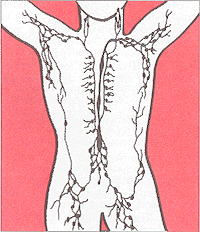Difference between revisions of "Lymphatic system" - New World Encyclopedia
Jyoti Sharma (talk | contribs) |
|||
| Line 1: | Line 1: | ||
| + | {{Contracted}} | ||
'''Lymph''' originates as [[blood plasma]] lost from the [[circulatory system]] due to hydrostatic pressure, which forces plasma to leak out of the blood vessel into the surrounding tissues. The '''lymphatic system''' collects this fluid by [[diffusion]] into lymph [[capillaries]] and returns it to the circulatory system in order to prevent dehydration. Once within the lymphatic system, the fluid is called lymph and has a very similiar composition to the original [[interstitial fluid]]. | '''Lymph''' originates as [[blood plasma]] lost from the [[circulatory system]] due to hydrostatic pressure, which forces plasma to leak out of the blood vessel into the surrounding tissues. The '''lymphatic system''' collects this fluid by [[diffusion]] into lymph [[capillaries]] and returns it to the circulatory system in order to prevent dehydration. Once within the lymphatic system, the fluid is called lymph and has a very similiar composition to the original [[interstitial fluid]]. | ||
[[Image:lymphatic_system.gif|framed|200px|The human lymphatic system]] | [[Image:lymphatic_system.gif|framed|200px|The human lymphatic system]] | ||
Revision as of 17:53, 31 May 2006
Lymph originates as blood plasma lost from the circulatory system due to hydrostatic pressure, which forces plasma to leak out of the blood vessel into the surrounding tissues. The lymphatic system collects this fluid by diffusion into lymph capillaries and returns it to the circulatory system in order to prevent dehydration. Once within the lymphatic system, the fluid is called lymph and has a very similiar composition to the original interstitial fluid.
Lymphatic circulation
The lymphatic system acts as a secondary circulatory system. Unlike the circulatory system, the lymphatic system is not closed and has no central pump; the lymph moves slowly and under low pressure due mostly to the milking action of skeletal muscles. Like veins, lymph vessels have one-way valves and depend mainly on the movement of skeletal muscles to squeeze fluid through them. Rhythmic contraction of the vessel walls may also help draw fluid into the lymphatic capillaries. This fluid is then transported to progressively larger lymphatic vessels culminating in the right lymphatic duct (for lymph from the right upper body) and the thoracic duct (for the rest of the body); these ducts drain into the circulatory system at the right and left subclavian veins.
Lymph vessels are present in the lining of the gastrointestinal tract. While most other nutrients absorbed by the small intestine are passed on to the portal venous system to drain, via the portal vein, into the liver for processing, fats are passed on to the lymphatic system, to be transported to the blood circulation via the thoracic duct. The enriched lymph originating in the lymphatics of the small intestine is called chyle. The nutrients that are released to the circulatory system are processed by the liver, having passed through the systemic circulation. The lymph system is a one-way system (interstitial fluid back to blood).
Secondary lymphoid organs
The spleen, lymph nodes, and accessory lymphoid tissue are the secondary lymphoid organs. These organs contain a scaffolding that support circulating B- and T-lymphocytes and other immune cells like macrophages and dendritic cells. When micro-organisms invade the body or the body encounters other antigens (such as pollen), the antigens are transported from the tissue to the lymph. The lymph is carried in the lymph vessels to regional lymph nodes. In the lymph nodes, the macrophages and dendritic cells phagocytose the antigens, process them, and present the antigens to lymphocytes, which can then start producing antibodies or serve as memory cells to recognize the antigens again in the future.
External links
- The Lymphatic System (MedicalEngineer.co.uk)
- Lymphatic System Overview (innerbody.com)
See also
- Thomas Bartholin and Olaus Rudbeckius, the discoverers of the lymphatic system in humans.
- History of anatomy in the 17th and 18th centuries
- Lymph Node
- Lymphedema, a condition of localized fluid retention caused by a compromised lymphatic system
| Immune system - edit |
|---|
| Humoral immune system | Cellular immune system | Lymphatic system | White blood cells | Antibodies | Antigen (MHC) | Complement system | Inflammation | Clotting factors |
| Lymphatic system - edit |
|---|
| Lymph nodes | Lymph | Lymphocytes | Lymph vessels | Thoracic duct | Immune system | Bone marrow | Spleen | Thymus | Tonsils |
| Human organ systems |
|---|
| Cardiovascular system | Digestive system | Endocrine system | Immune system | Integumentary system | Lymphatic system | Muscular system | Nervous system | Skeletal system | Reproductive system | Respiratory system | Urinary system |
Credits
New World Encyclopedia writers and editors rewrote and completed the Wikipedia article in accordance with New World Encyclopedia standards. This article abides by terms of the Creative Commons CC-by-sa 3.0 License (CC-by-sa), which may be used and disseminated with proper attribution. Credit is due under the terms of this license that can reference both the New World Encyclopedia contributors and the selfless volunteer contributors of the Wikimedia Foundation. To cite this article click here for a list of acceptable citing formats.The history of earlier contributions by wikipedians is accessible to researchers here:
The history of this article since it was imported to New World Encyclopedia:
Note: Some restrictions may apply to use of individual images which are separately licensed.
